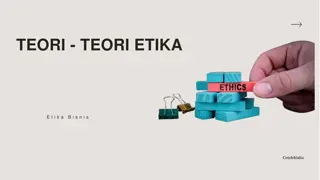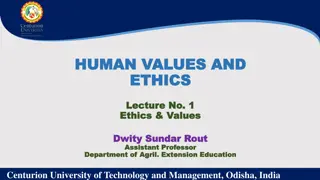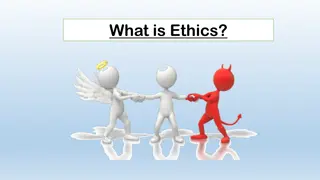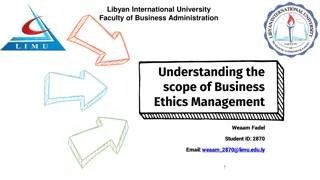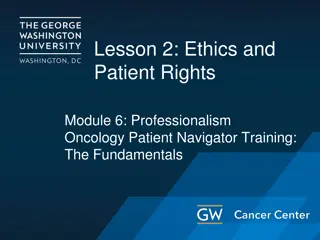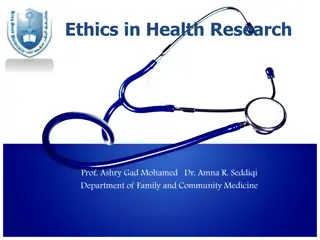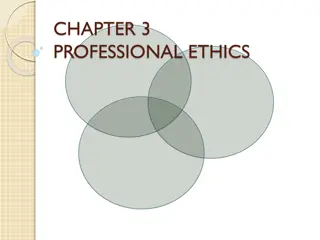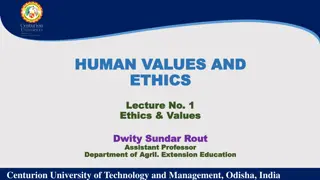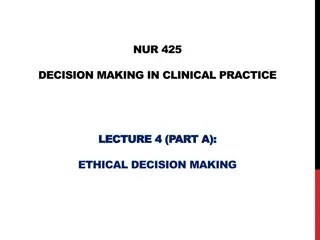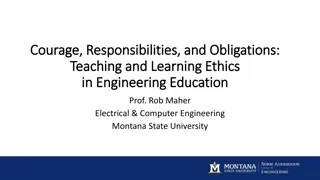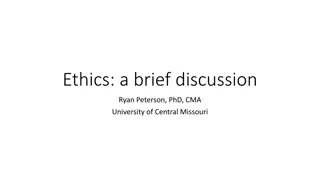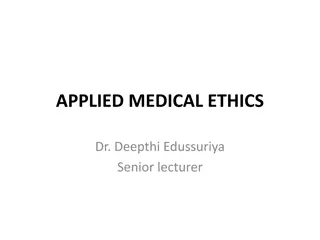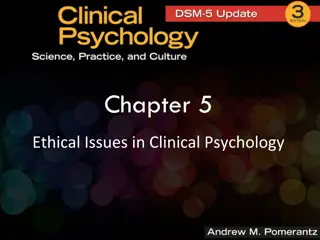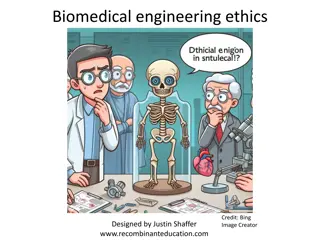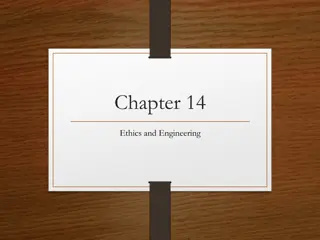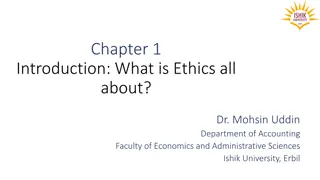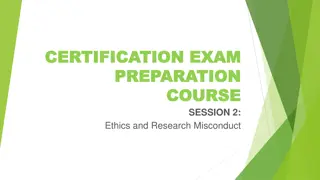Professional Ethics in Engineering: Senses of Ethical Issues
This content delves into engineering ethics, exploring moral dilemmas, autonomy, ethical theories, and professionalism. It aims to develop awareness of ethical issues and responsibilities in the field of engineering. The study encompasses moral decision-making, moral ideals, and ethical frameworks applicable to individuals and organizations in technological activities. Various impediments to ethical responsibility are discussed, along with training in preventive ethics to stimulate moral imagination and analytical skills. The expression of engineering ethics is highlighted as an area of inquiry involving moral values and issue resolution distinct from non-moral problems.
Download Presentation

Please find below an Image/Link to download the presentation.
The content on the website is provided AS IS for your information and personal use only. It may not be sold, licensed, or shared on other websites without obtaining consent from the author.If you encounter any issues during the download, it is possible that the publisher has removed the file from their server.
You are allowed to download the files provided on this website for personal or commercial use, subject to the condition that they are used lawfully. All files are the property of their respective owners.
The content on the website is provided AS IS for your information and personal use only. It may not be sold, licensed, or shared on other websites without obtaining consent from the author.
E N D
Presentation Transcript
GE GE2025 2025- - PROFESSIONAL ETHICS PROFESSIONAL ETHICS IN ENGINEERING IN ENGINEERING Reference: New York (2005). Mike Martin and Roland Schinzinger, Ethics in Engineering , McGraw Hill,
UNIT I Engineering Ethics
Unit I Senses of Engineering Ethics Variety of moral issues Types of inquiry Moral dilemmas Moral Autonomy Kohlberg s theory & Gilligan s theory Consensus and Controversy Professions and Professionalism Professional Ideals and Virtues and Uses of Ethical Theories.
The Goal The course will develop a framework on which professional and ethical issues can be analyzed, Build up an awareness of various views of ethical issues as well as professionals ethical rights and responsibilities.
ENGINEERING ETHICS The study of moral issues and decisions confronting individuals and organizations involved in engineering and The study of related questions about moral ideals, character, policies and relationships of people and organizations involved in technological activity. {* Confronting Challenging * ideals - Principles}
TRAINING IN PREVENTIVE ETHICS Stimulating the moral imagination Recognizing ethical issues Developing analytical skills Eliciting a sense of responsibility Tolerating disagreement and ambiguity
Self-interest. Fear. Self-deception. Ignorance. Egocentric tendencies. Microscopic vision. Groupthink. IMPEDIMENTS TO RESPONSIBILITY
SENSES OF EXPRESSION OF ENGINEERING ETHICS Ethics is an activity and area of inquiry. It is the activity of understanding moral values, resolving moral issues and the area of study resulting from that activity. When we speak of ethical problems, issues and controversies, we mean to distinguish them from non moral problems. Ethics is used to refer to the particular set of beliefs, attitudes and habits that a person or group displays concerning moralities. Ethics and its grammatical variants can be used as synonyms for morally correct .
WHAT IS MORALITY? The term morality concerns with what ought or ought not to be done in a given situation? what is right or wrong in handling it? what is good or bad about the persons, policies and principles involved in it? If an action is said to be morally right it should had some moral reasons.
MORAL REASONS Moral reasons include Respecting others and ourselves, Respecting the rights of others, Keeping promises, Avoiding unnecessary problems to others Avoiding cheating and dishonesty, Showing gratitude to others and encourage them to work
VARIETIES or APPROACHES OF MORAL ISSUES MICRO-ETHICS: This approach stresses more about some typical and everyday problems which play an important role in the field of engineering and in the profession of an engineer MACRO-ETHICS: This approach deals with all the social problems which are unknown and suddenly burst out on a regional or national level
TYPES OF INQUIRY Inquiry means an investigation:- Engineering ethics involves investigations into values, meaning and facts. Normative Inquiries Conceptual Inquiries Factual or Descriptive Inquiries
NORMATIVE INQUIRY These are about what ought to be and what is good . These questions identify and also justify the morally desirable norms or standards. Some of the questions are: A. How far engineers are obligated to protect public safety in given situations? B. When should engineers start whistle blowing on dangerous practices of their employers? C. Whose values are primary in taking a moral decision, employee, public or govt? D. Why are engineers obligated to protect public safety? E. When is govt justified in interfering on such issues and why?
CONCEPTUAL INQUIRY: These are meant for describing the meaning of concepts, principles, and issues related to Engineering Ethics. Examples are: What is SAFETY and how is it related to RISK Protect the safety, health and welfare of public-What does this statement mean? What is a bribe? What is a profession and who are professionals?
FACTUAL (DESCRIPTIVE) INQUIRIES These help to provide facts for understanding and finding solutions to value based issues. These are inquiries used to uncover information using scientific techniques. These inquiries get to information about business realities, history of engineering profession, procedures used in assessment of risks and engineers psychology.
MORAL DILEMMMA Why study engineering ethics? Engineering ethics is not only teaching moral behavior in knowing about immoral in a set of beliefs, but also increasing the ability of engineers and other professionals to face boldly with the moral problems arising advancements, changes activities. from and technological other related
MORAL DILEMMMA Dilemmas are certain kind of situations in which a difficult choice has to be made. Moral dilemmas have two or more foldings - moral obligations, duties, rights, goods or ideals come into disagreement with each other. One moral principle can have two or more conflicting applications for a particular given situation.
MORAL DILEMMMA There are three types of complexities. VAGUENESS: ( ): This complexity arises due to the fact that it is not clear to individuals as to which moral considerations or principles apply to their situation. CONFLICTING REASONS ( ): Even when it is perfectly clear as to which moral principle is applicable to one s situation, there could develop a situation where in two or more clearly applicable moral principles come into conflict. DISAGREEMENT( ): Individuals and groups may disagree how to interpret, apply and balance moral reasons in particular situations.
STEPS / PROCEDURES IN FACING MORAL DILEMMAS Identifying the relevant moral factors and reasons: i.e. Finding solutions for (i) the conflicting responsibilities (ii) the competing rights and (iii) the clashing ideals involved. Collecting and gathering all the available facts which are relevant to the moral factors while resolving. Ranking the moral considerations or principles on the basis of importance as applicable to the situation. Considering alternative courses of action for resolving the problems and tracing the full implications of each. i.e. conducting factual inquiries. Having talked with the colleagues, friend about the problem getting their suggestions and alternative ideas on resolving that dilemma. Arriving at a careful and reasonable judgment or solution by taking into consideration of all important moral factors and reasons on the basis of the facts or truths.
MORAL AUTONOMY Autonomy means self-governing or self-determining i.e act independently. Moral autonomy is concerned with the independent attitude of a person related to ethical issues. It helps to improve the self-determination among the individuals. Autonomous individuals think for themselves and do not assume that customs are always right. They seek to reason and live by general principles. Their motivation is to do what is morally reasonable for its own sake, maintaining integrity, self-respect, and respect for others
SKILLS FOR IMPROVING MORAL AUTONOMY The engineers must have the ability to distinguish and relate these moral problems with the problems of law, economics, religions principles etc. They must possess(have) the skills of understanding, clarifying and assessing the arguments which are against the moral issues. They must have the ability to suggest the solutions to moral issues, on the basis of facts. These suggestions must be consistent and must include all the aspects of the problem. They must have the imaginative skill to view the problems from all view points and also be able to suggest a proper alternative solution.
SKILLS FOR IMPROVING MORAL AUTONOMY They must be able to tolerate while giving moral judgments and decisions which may cause trouble.( i.e. they have to understand the difficulties in making moral decisions.) They must have adequate knowledge and understanding about the use of ethical language so as to defend or support their views with others. They must have some better knowledge in understanding the importance of suggestions and better solutions while resolving moral problems and also about the importance of tolerance on some critical situations. They must understand the importance of maintaining the moral honesty i.e. the personal convictions and beliefs and individual s professional life must be integrated. They must have this skill of doing so.
KOHLBERGS THEORY Moral Autonomy is based on the psychology of moral development. The first psychological theory was developed by Jean Piaget On the basis of Piaget s theory, Lawrence kohlberg developed three main levels of moral development Which is based on the kinds of reasoning and motivation adopted by individuals with regard to moral questions.
STAGES OF MORAL DEVELOPMENT Pre-conventional Level: It is nothing but self-centered attitude. In this level, right conduct is very essential for an individual which directly benefits him According to this level, individuals are motivated by their willingness to avoid punishment, or by their desire to satisfy their own needs This level is related to the moral development of children and some adults who never want to go beyond a certain limit.
STAGES OF MORAL DEVELOPMENT Conventional Level: As per this level the rules and norms of one s family or group or society has been accepted as the final standard of morality. When individuals are under this level, always want to satisfy others and also to meet the expectations of the society and not their self interest. No adult tries to go beyond this level.
STAGES OF MORAL DEVELOPMENT Post- Conventional Level: This level is said to be attained when an individual recognizes the right and the wrong on the basis of a set of principles which governing rights and the general good which are not based on self- interest or social conventions. These individuals are called autonomous , because they only think for themselves and also they do not agree that customs are always correct. They want to live by general principles which are universally applied to all people.
Lawrence Kohlberg Kohlberg s theory of moral development is very much related to the goals of studying ethics at college level Moral responsibility comes out of the foundation of early moral training given by an individual s parents and culture. As per Kohlberg s view only few people would reach the post conventional level
Kohlbergs Theory of Moral Development Each level is based on the degree to which a person conforms to conventional standards of society Each level has two stages that represent different degrees of sophistication in moral reasoning.
Criticisms of Kohlbergs theory Research has not supported Kohlberg s belief that the development of abstract thinking in adolescence invariably leads people to the formation of idealistic moral principles Some cross-cultural psychologists argue that Kohlberg s stories and scoring system reflect a Western emphasis on individual rights, harm, and justice that is not shared in many cultures. Kohlberg s early research was conducted entirely with male subjects, yet it became the basis for a theory applied to both males and females.
GILLIGANS THEORY Pre-conventional Level This is the same as Kohlberg s first level in that the person is preoccupied with self centered reasoning, caring for the needs and desires of self. Conventional Here the thinking is opposite in that, one is preoccupied with not hurting others and a willingness to sacrifice one s own interests in order to help or nurture others (or retain friendship). Post-conventional Level Achieved through context-oriented reasoning, rather than by applying abstract rules ranked in a hierarchy of importance. Here the individual becomes able to strike a reasoned balance between caring about other people and pursuing one s own self-interest while exercising one s rights.
Carol Gilligans Model Feels Kohlberg s model is based on an ethic of individual rights and justice, which is a more common perspective for males Gilligan s model of women s moral development is based on an ethic of care and responsibility. However, when subjects are carefully matched, there do not seem to be systematic gender differences in moral reasoning
CONSENSUS AND CONTROVERSY Consensus Agreement Controversy Disagreement
CONTROVERSY All individuals will not arrive at same verdict during their exercising their moral autonomy. Aristotle noted long ago that morality is not as precise and clear-cut as arithmetic. Aim of teaching engineering ethics is not to get unanimous conformity of outlook by indoctrination, authoritarian and dogmatic teaching, to improve promotion of tolerance in the exercise of moral autonomy hypnotism or any other technique but. [* unanimous Common * verdict- decision * indoctrination instruction * authoritarian, dogmatic - strict]
CONSENSUS The conductor of a music orchestra has authority over the musicians and his authority is respected by them by consensus as otherwise the music performance will suffer. Hence the authority and autonomy are compatible. On the other hand, tension arises between the needs for autonomy and the need for concerns about authority. The difference between the two should be discussed openly to resolve the issue to the common good.
Membership Criteria Complete Bachelors degree Performing work commonly recognized as what engineers do Being officially and licensed as a PE. Acting in morally responsive ways while practicing engineers
Differing views on Professionals Only consulting engineers who are basically independent and have freedom from coercion can be called as professionals. -Robert L.Whitelaw Professionals have to meet the expectations of clients and employers. Professional restraints are to be imposed by only laws and government regulations and not by personal conscience. -Samuel Florman * Coercion Pressure * Restraints- limits
Characteristics of Professions Profession- meet the following criteria Knowledge Organization Public Good Who is Professional? Knowledge:- skills cant be mechanized Organization: IEEE, ASME Public Good: to protect public health safety welfare
Professionalism Qualities, competencies and Skills of professionals
MOTIVES FOR PROFESSIONALISM A desire for interesting and challenging work and the pleasure in the act of changing the world. The joy of creative efforts. Where a scientist s interest is in discovering new technology, engineers interest is derived from creatively solving practical problems. The engineer shares the scientist s job in understanding the laws and riddles of the universe. The sheer magnitude of the nature oceans, rivers, mountains and prairies leads engineers to build engineering marvels like ships, bridges, tunnels, etc., which appeal to human passion. *Sheer - pure
MODELS OF PROFESSIONAL ENGINEERS SAVIOR: The representative engineer is a savior who will redeem society from poverty, inefficiency, waste and the drudgery of manual labor. GUARDIAN: Engineers know, the directions in which and pace at which, technology should develop. BUREAUCRATIC SERVANT: The engineer as the loyal organization person uses special skills to solve problems. SOCIAL SERVANT: Engineers, in co-operation with management, have the task of receiving society s directives and satisfying society s desires. Social ENABLER AND CATALYST GAME PLAYER * Savior Rescuer
Professional Ethics & Virtes Virtue means Good character of an individual It is defined as moral distinction of goodness It can be defined as excellence of moral behavior
The Four Main Virtues Prudence (mind)( ): to think about a moral problem clearly and completely Temperance (emotions)( ): control attraction to positive emotions Fortitude (emotions) ( ): control aversion for negative emotions Justice (will)( ): choose according to truth and fairness.
Virtue Ethics Focuses on the type of person we should strive to be Actions which reflect good character traits (virtues) are inherently right Actions which reflect bad character traits (vices) are inherently wrong Virtue ethics are tied more to individual behavior than to that of an organization (e.g. business, government) Bad Wrong actions Vices character
Professional Responsibility Virtues Defining Professional Responsibility. Professional responsibility means being morally responsible as a professional Classification of virtues: Self Directional Virtues Public Spirited Virtues Teamwork Virtues Proficiency Virtues
Professional Responsibility 1. SELF DIRECTION VIRTUES: Fundamental virtues in exercising our moral autonomy and responsibility. e.g. self understanding, humility, good moral judgment, courage, self discipline, perseverance, commitments, self-respect and dignity 2. PUBLIC SPIRITED VIRTUES: Focusing on the benefit of the clients and society. 3 important public spirited virtues Justice, Sense of community, generosity 3. TEAMWORK VIRTUES: Enables professionals to work successfully with others. E.g. collegiality, cooperativeness, the ability to communicate, respect for authority, loyalty to employers and leadership qualities. 4. PROFICIENCY VIRTUES: (intellectual Virtue) Mastery of one s craft that characterize good engineering practice e.g. competence, diligence, creativity, self-renewal through continuous education (mastery over the profession)
Types of Ethical Theories Theory Virtue Ethics Theory Right Ethics Theory Duty Ethics Theory Utilitarianism theory Basic Concept Virtues and Vices Human Rights Duties to respect persons Most good for the most people


